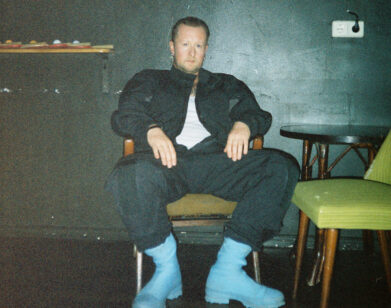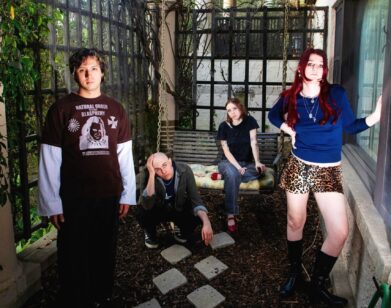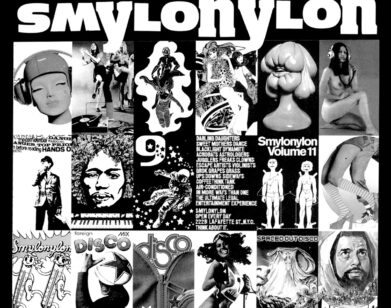Pity Sex’s Unconventional Pop

ABOVE: PITY SEX. PHOTO COURTESY OF JOEL RAKOWSKI.
Based in the unassuming city of Ann Arbor, Michigan, Pity Sex released their breakthrough debut, Feast of Love, in 2013. Now, the quartet is gearing up for their sophomore effort, White Hot Moon (out April 29). In the past three years, Sean St. Charles, Brennan Greaves, Britty Drake, and Brandan Pierce learned to write the music more collaboratively, bringing in everyone’s perspectives and suggestions. “This is the first record that has been really diplomatic in the way it was written and it’s definitely affected the sound,” St. Charles explains. Once the overall sound is developed, Drake and St. Charles divide the lyrical process. Through lo-fi bass and muted, electronically modified vocals that suddenly burst into an upbeat, unconventional pop song, the track “Bonhomie,” which we’re pleased to premiere below, reflects the overall sonic explorations of the album.
“I don’t know if there’s a lyrical cohesion throughout the record; the thought is playing with pop conventions, messing with expectations,” St. Charles says. “We’re like, ‘How do you make a ballad interesting?’ Do you make it overwrought in a way that’s funny or do you approach it more subtly?”
In addition to the release of “Bonhomie,” earlier this morning Pity Sex announced a North American tour that will bring them from Ann Arbor to New York, Philadelphia, Atlanta, Houston, Los Angeles, and more this summer. We caught up with St. Charles over the phone.
EMILY MCDERMOTT: Can you tell me about “Bonhomie”?
ST. CHARLES: The band writes the bulk of the instrumentation together, and when the song starts coming together that’s when we decide who’s going to write vocals and lyrics. So the song sounded almost like it does now and to me it’s like, “This is a pop song, in a way we don’t always do,” so my inspiration was trying to make it interesting. I liked the thought of a song that’s banal and crass, in a way that’s often off-putting in a relationship song. This is like a bratty love song, but since there are two perspectives it’s not overbearing. They’re both a little immature, juvenile. There’s something that’s endearing when you see both sides of a relationship and both people are acting a little immature.
MCDERMOTT: You said writing this album was diplomatic, but everyone has struggles. What is one that you faced when writing the music together?
ST. CHARLES: It’s often frustrating to try to flesh out what comes next when it’s four people in a room playing music. Brennan and I have known each other since we were four years old and we’ve been playing together since we were in middle school. We’ve only ever played with each other and we have a lot of chemistry. We’re pretty good at sitting down—he’ll play something and I’ll play something—for hours. A lot of times it’s not good but it’s fun. It’s frustrating when we’re doing something like that and Britty’s like, “You have to slow down so I can fit in here somehow.” Understanding that that process is always helpful, learning when collaboration is good, and learning when taking a step back and working individually is good. That’s the biggest thing that we struggle with when we’re writing.
MCDERMOTT: Aside from writing more collaboratively, how else do you think you have grown as a band since Feasts of Love?
ST. CHARLES: I think it’s a matter of approaching the music with more confidence. We’ve all retained a level-headedness when it comes to how we approach music, because we all went to college and heave career paths in mind. Playing music has always been something we’ve done because we like it, not something we do because we’re desperate for a career in it. Over time it becomes second nature, and I think that’s reflected in the songs. They’re more dynamic because it comes together more naturally. That’s true for writing and definitely true for recording. We were so familiar with how to record with Will Yip, who produces our records, that we didn’t have to think about it. We just think about how the songs work.
MCDERMOTT: Having mentioned college and the career path, I read an interview with Britty where she talked about her degree from the University of Michigan. Where did you go and what did you study?
ST. CHARLES: I also went to University of Michigan. If you’re from Michigan and you do well in high school it’s almost expected that you go to the University of Michigan. It’s interesting now having friends from the East Coast who are like, “Yeah, you go all over the place, you never go to the big state schools.” That’s not a thought in the Midwest. If you live within five hours from your state school, you go there. So I went to University of Michigan and I studied English literature and creative writing.
MCDERMOTT: So what’s your career path, per se?
ST. CHARLES: Initially I really wanted to get an MFA in creative writing. I got into The New School for poetry, but I didn’t go. That was right when the band was taking off and I figured, “I’ll just wait, do some band stuff.” I’ve always been interested in more serious literary writing, but I don’t know…Working in publishing, working for magazines, that stuff has always interested me.
MCDERMOTT: Who are some of your favorite authors or poets?
ST. CHARLES: I predominantly read fiction, short stories. I really like Stuart Dybek, who’s from Chicago and lived in Michigan, so he writes a lot about Michigan. I also like Joy Williams. I’m interested in people who approach the short story as a really specific thing that you can’t do in a novel forms. I like people who take big risks or use the conceits of that form. Lydia Davis is a good example of someone who does something in five pages that you couldn’t do in 400 pages. I’m really interested in flash fiction, which intersects what I like about poetry in that it’s really singular, and what I like about fiction, which is that the voice can be more conversational.
MCDERMOTT: That makes a lot of sense. So when you’re not writing songs do you find yourself writing short stories or poems?
ST. CHARLES: Definitely. A lot of times, when I’m looking for inspiration in regards to songwriting, stuff comes from what I’m reading. Song titles or lyrics come from stuff I’m reading. “Bonhomie” is a word I came across in this Julio Cortazar novel and that I’d never seen before. When I looked it up I was like, “That’s a funny way to approach this song.”
MCDERMOTT: I read that you were inspired by Yo La Tengo and Sonic Youth for this album. Can you talk about why they were so influential?
ST. CHARLES: Yo La Tengo is the perfect example of what a record should be like. I like bands that approach records as not just a collection of songs, but that are trying to do different things. Not every song has to be catchy or quantifiably good. Yo La Tengo has a really good ear for developing sounds on a record, and developing them in certain ways. That’s something we wanted to do [on this album]. I also like bands that have really long careers, like Sonic Youth and Yo La Tengo. They can take risks on a record because it doesn’t really matter. A record doesn’t have to be any specific thing, the end all be all. You can do a record that’s like, “I want to explore this specific theme or this type of sound.”
MCDERMOTT: You all could have relocated after graduating from school, but you’re still living in Ann Arbor. Why did you decide to stay?
ST. CHARLES: We felt anchored in Ann Arbor. The band was never at a point where we could split up across the country and make it work. It seemed like something that was worth staying close by for. Living in the Midwest or Ann Arbor influences us in a couple ways. One, you’re so far detached from any sort of scene. If you live in New York or Philadelphia, you could do a show every night or see a show every night. It’s easy to become a band that’s popular in New York because you’re being seen by people every day and that’s not true in the Midwest. But also living in a weirdo liberal place like Ann Arbor is cool because everything feels so low stakes. Nobody in town is watching or cares, so you can do your thing without expectation. That leaves more room to do exactly what you want, which has always been a thing for this band.
MCDERMOTT: So, I’m looking at the album artwork. What is the story behind the neon elephant?
ST. CHARLES: [laughs] This is the first time we’ve done something that isn’t specifically patterned, which was a challenge. We had the record title in mind and colors are a big thing. We’ll pick the color of the cover and think about what images would work well with it. We liked the thought of using neon lights, but that specific image is from a really famous arcade in Ann Arbor called Pinball Pete’s. That elephant is their logo, and in the front window there’s that sign and mannequin head behind it. One day Brennan was just walking by, he had never noticed the two in conjunction, and he captured it in a way that made a lot of color overall. Once we had the picture it was pretty clear that “This is the one, this is what we’re going for for the record, and the image is really interesting.”
“WHITE HOT MOON” WILL BE RELEASED APRIL 29 VIA RUN FOR COVER RECORDS AND IS AVAILABLE TO PRE-ORDER HERE. FOR MORE ON PITY SEX, VISIT THE BAND’S FACEBOOK.






